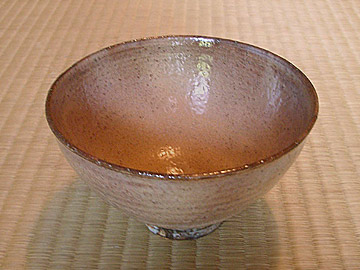Hagi
ware. A general name for pottery made in the Matsumoto ¼{ area of western Hagi
City and in Nagato Fukawa ·å[ì in present-day Yamaguchi prefecture The kilns were
sponsored by Mouri Terumoto ÑP³(1553-1625) who brought the Korean potter brothers
Yi Kyong (Jp: Li Kei h) and Yi Chak-kwang (Jp: Li Shakkou Ùõ) to Hagi, the new clan seat in 1604. Reflecting
the simple tea taste sought by the Mouri patrons, hagiyaki, especially
teabowls, recall Korean Ido äË ware. The 1717 discovery of the daidoutsuchi
å¹y clay, which produced subtle changes in color and texture during pine-fueled
firing, was instrumental in the development of hagiyaki; when mixed with
the more fire-resistant mitaketsuchi àõy clay, the changes multiplied.
Hagi pots are very rarely decorated with painted motifs, but rely on wood-ash
glazes like isabaiyuu mDçÖ, or a straw-ash glaze shirohagigusuri
çÖ, to create a lightly colored surface. The muted qualities of Hagi ware evolve
with use because the clay absorbs some of the liquid in a process called chanare
µ or hagi-no-nanabake ̵»¯ (the seven changes in Hagi). A wedge was
often cut into the foot of the bowl. Purposely damaging goods was a formalized
gimmick to allow potters to sell to commoners when hagiyaki was reserved
for the upper class. Tea bowls, flower vases and sake vessels are the most common
Hagi ware.
|

